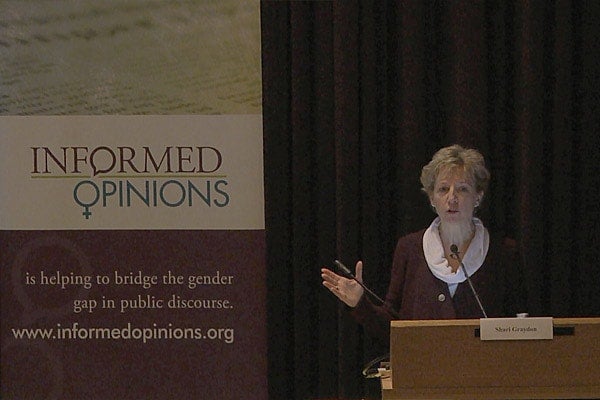
Improving women’s participation in the public discourse
Published: February 1, 2012
Research shows that female academic experts are seriously under-represented in the media, and this means that readers often lack a broader perspective on an issue, says a former journalist who monitors and studies female representation in the media.
Shari Graydon, the founder of the Informed Opinions project, was the keynote speaker at a Jan. 31 event called Bridging the Gender Gap in the News: A Public Talk & Panel Discussion, held at U of T’s Ontario Institute for Studies in Education (OISE). The award-winning author found an attentive audience, as U of T staff and faculty heard some startling statistics and Graydon’s recommendations.
Graydon’s research shows that even though women constitute 61 per cent of university graduates, their perspectives account for fewer than 20 per cent of the commentaries in Canada’s largest daily newspapers and on public affairs talk shows.
“It’s impossible to calculate what’s not in the media as a result of our experiences not being reflected and not being represented,” said Graydon.
She touched on some of the reasons for this gap.
“Our research found that many times the reason women will decline interviews is because of time. We also expect ourselves to be more qualified than our male counterparts in order to consider ourselves experts.”
Professor Megan Boler of the OISE, Kathy English, public editor for the Toronto Star, and Esmé Fuller-Thompson, professor and Sandra Rotman Chair in Social Work, joined Graydon as panellists at the symposium.
Fuller-Thompson sees the value of having her work disseminated, even though media interviews may be difficult initially. She tests her planned interview responses with her own four children as a way of preparing for media interviews.
“I usually use the teens to start with, and if they understand what I’m discussing, then I work down to the 12-year-old,” said Fuller-Thompson. “If what I’m talking about is clear to her then I’m probably talking at the right level.
“I think researchers have a tendency to talk to each other and we aren’t always able to translate our research in a way that’s of value outside our specific discipline.”
Graydon noted the consequences of under-representation. She works with women and journalists to change the ratio.
“As long as women are not contributing op-eds to the major newspapers across the country, our perspectives and the diversity of them are not there,” she told the audience.
Graydon talked about the major reasons women should bring their voices to these arenas, including the need to establish a pattern.
“We really need to be providing role models for young women. The absence of women on the op-ed pages is a self-perpetuating problem.”
English, an experienced print journalist, said she consistently found that women were not willing to write op-ed pieces.
“It was very hard for women to rejig their schedules,” said English. “I also found they were very reluctant to lose control of their scholarship to the media.”
Boler, a U of T researcher often called upon by media for expert comment on pop culture, the media and social media, agreed that women need to make the effort to speak out and be heard.
“What’s important to me is to figure out how our research can move out of the ivory tower,” said Boler. “It’s such a privilege for those of us who are in the university and have the privilege to speak for others, particularly if we’re working on issues that have importance for policy and legislation and for broadening the continuum.”



